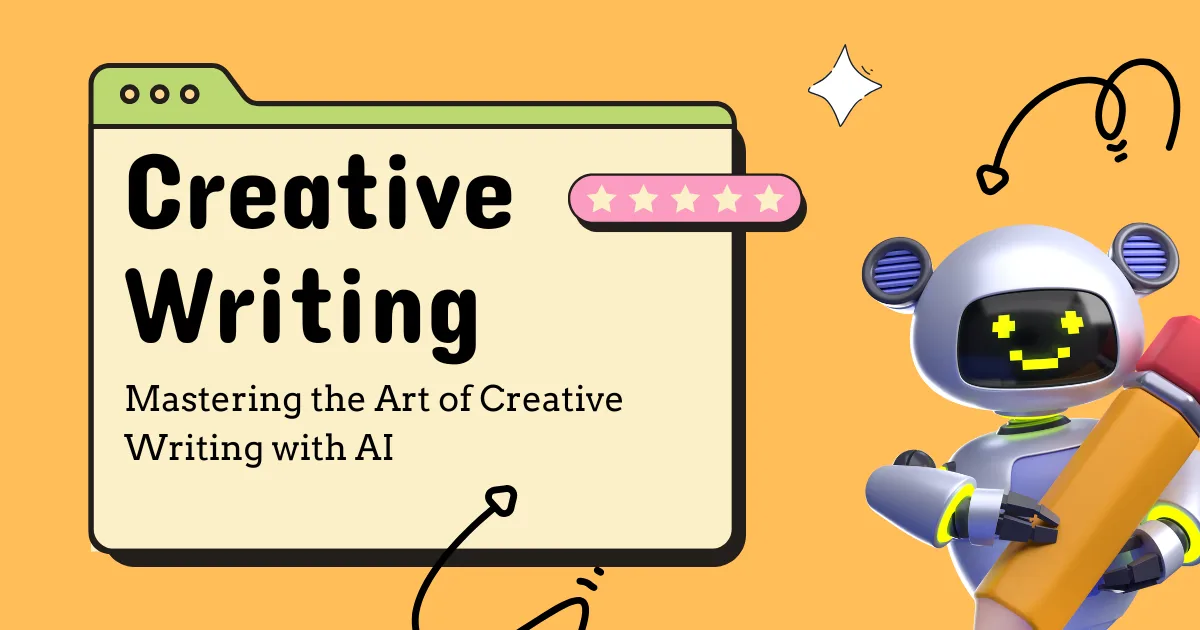In today’s fast-paced digital world, writing with AI has become increasingly common. Content creators, marketers, bloggers, and professionals across industries are turning to artificial intelligence to speed up their writing process. But there’s a catch – AI-generated content often lacks that human touch. It can feel mechanical, cold, and formulaic. The good news? With the right techniques, you can transform robotic AI writing into content that feels authentic and engaging.
The Rise of Writing With AI
Writing with AI tools has revolutionized content creation. What once took hours can now be accomplished in minutes. From blog posts to marketing copy, email sequences to social media captions, AI writing assistants have changed the game forever.
But as more people embrace writing with AI, a new challenge has emerged. Readers have become increasingly sensitive to the telltale signs of machine-generated text. They crave authenticity in a digital landscape flooded with cookie-cutter content. Editors and publishers have grown wary of submissions that lack personality. Even AI detection tools, despite their flaws, can flag content that hasn’t been properly humanized.
“I submitted an article to a publication I’ve worked with for years, and they rejected it because they thought I used AI,” shares Maria, a freelance writer. “The irony? I wrote every word myself. My naturally formal writing style was misinterpreted as machine-generated.”
Maria’s experience isn’t unique. As writing with AI becomes more prevalent, even human writers can find themselves caught in the crossfire of heightened scrutiny.
Understanding Why AI Writing Sounds Artificial
Before we can fix the problem, we need to understand why writing with AI often produces content that feels “off” to human readers.
AI writing tools lack lived experiences. They don’t have memories or emotions. They can’t draw from personal interactions or sensory experiences. Instead, they analyze patterns in existing text and generate content that statistically fits those patterns.
When writing with AI, you’re essentially working with a sophisticated pattern-matching system. It excels at creating grammatically correct sentences and following content structures it has observed. But it struggles with nuance, emotional depth, and the unpredictable creativity that makes human writing captivating.
Think about it this way: AI writing is like someone trying to cook a meal by following statistical patterns of successful recipes without ever having tasted food. They might get the techniques right, but something will always be missing in the final dish.
The good news? Writing with AI doesn’t mean you must accept bland, robotic content. With thoughtful editing and a few key strategies, you can inject humanity back into machine-generated text.
Seven Signs of AI Writing (And How to Fix Them)
When writing with AI, you’ll likely encounter these common issues that signal machine-generated content. Let’s explore each problem and how to solve it.
1. Safe, Generic Language That Lacks Personality
AI writing tools prioritize safety. They’re designed to avoid controversy and stay neutral, which often results in bland statements that feel impersonal.
The Problem: When writing with AI, you might notice it generates phrases like “This product could be beneficial for many users” or “Some people may find this approach helpful.” These statements are technically correct but lack conviction and personality.
The Solution: Take a stance. Writing with AI doesn’t mean you can’t inject your opinions and perspectives. Add sentences that show clear judgment or preference based on your experience.
Instead of keeping the AI’s lukewarm statement that “This software can be useful for many people,” revise it to something with more conviction: “After struggling with productivity for years, I’ve found this software to be a game-changer for freelancers juggling multiple clients. If you’re not using it yet, you’re seriously missing out.”
The revised version takes a clear position, incorporates personal context, and speaks directly to a specific audience. That’s something AI struggles to do authentically when writing with AI alone.
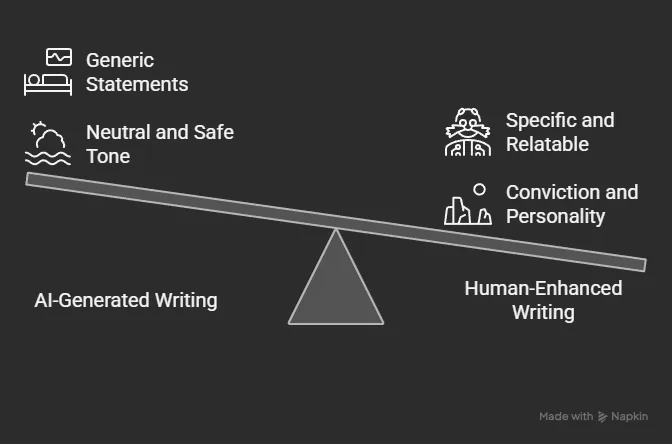
2. Monotonous Sentence Patterns
AI writing tools often fall into rhythmic patterns, creating a hypnotic but dull reading experience.
The Problem: When writing with AI, watch for repeated sentence structures and lengths. If every sentence follows the same subject-verb-object pattern with similar word counts, your content will drag despite being technically correct.
The Solution: Vary your rhythm deliberately. Writing with AI becomes more engaging when you mix short, punchy sentences with longer, more complex ones. Think about how you speak naturally – your conversation likely flows with varied pacing and emphasis.
Transform this AI-generated paragraph: “AI assists writers. It helps them work faster. It provides useful suggestions. It can generate multiple options.”
Into something more dynamic: “AI doesn’t just assist writers – it transforms how we approach the blank page. It helps us leap over writer’s block in seconds. And when you’re staring down a deadline with nothing but coffee and determination? That’s when writing with AI becomes not just helpful, but essential.”
Notice how the revised version mixes sentence lengths and structures while incorporating emotional context and conversational elements.
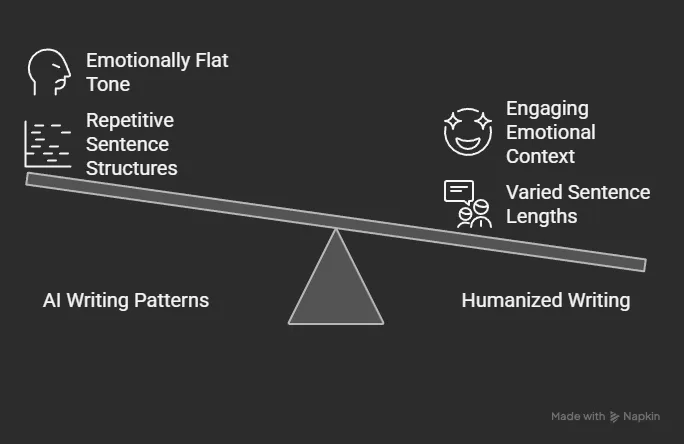
3. Excessive Wordiness and Repetition
When writing with AI, you might notice it tends to be unnecessarily verbose, often restating the same idea using slightly different phrasing.
The Problem: AI writing tools sometimes pad content with filler phrases and redundant statements. This happens because they’re trained to reach certain word counts and content structures, even when the core idea could be expressed more concisely.
The Solution: Be ruthless with your editing. When writing with AI, challenge every sentence by asking: “Does this add new information or value?” If not, delete it or combine it with another statement.
Instead of keeping this AI-generated text: “One of the most important and critical factors to take into consideration when thinking about improving and enhancing your writing is maintaining clarity and directness in your communication approach.”
Simplify it to: “Clarity cuts through noise. Master it first.”
By trimming excess verbiage, your writing with AI becomes punchier and more memorable.
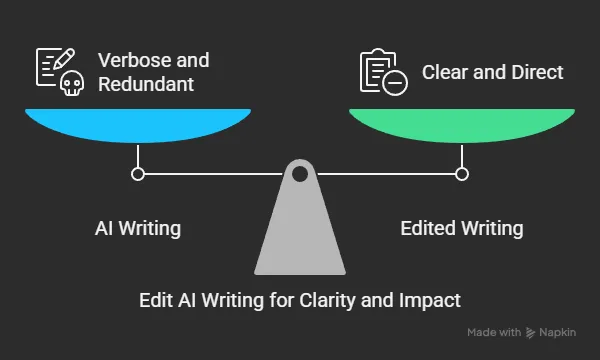
4. Absence of Personal Experience and Storytelling
Perhaps the most obvious sign of AI-generated content is the lack of authentic personal anecdotes and relatable stories.
The Problem: When writing with AI, the content typically lacks specific personal details, sensory descriptions, and authentic emotional reactions that come from lived experience.
The Solution: Infuse your real experiences into the text. Writing with AI becomes more authentic when you incorporate your own stories, observations, and sensory details that only you could know.
Transform this AI-generated statement: “Effective communication is important for business success.”
Into something more personal: “I still remember the pit in my stomach when I realized my vague email had cost us a $20,000 client. The project requirements weren’t clear, and they went with a competitor whose proposal addressed their specific needs. That painful lesson taught me that precise communication isn’t just important—it’s the difference between thriving and struggling.”
This revision incorporates specific details (the exact amount lost), physical sensation (pit in stomach), and a concrete consequence that demonstrates the point more effectively than any general statement could.
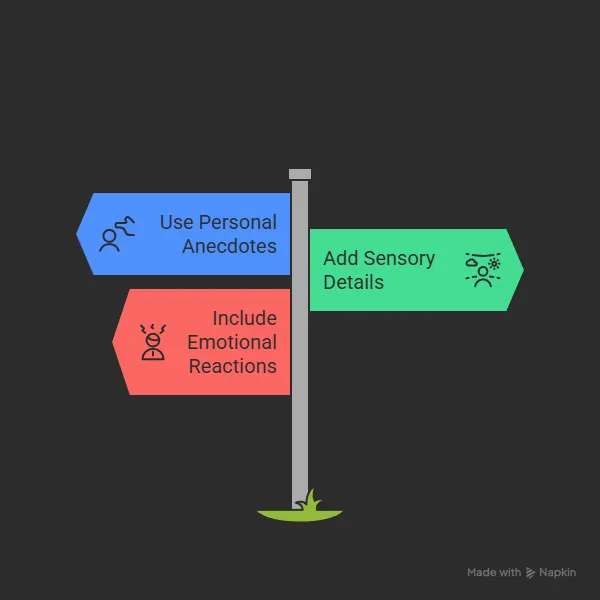
5. Reliance on Clichés and Overused Phrases
AI writing tools love familiar phrases that appear frequently in their training data.
The Problem: When writing with AI, you’ll often find tired expressions like “at the end of the day,” “think outside the box,” or “in this day and age.” These phrases may be grammatically correct, but they signal lazy thinking and lack of originality.
The Solution: Create fresh expressions or use specific industry terminology. Writing with AI improves dramatically when you replace clichés with original metaphors or comparisons drawn from your interests or experiences.
Instead of keeping the AI’s statement that “Success doesn’t happen overnight,” you might write: “Success in content marketing is less like winning the lottery and more like growing a sequoia tree—it takes consistent attention, the right conditions, and years of patient nurturing before you witness its impressive stature.”
This revision replaces a worn-out phrase with a specific, vivid metaphor that communicates the same idea more memorably.
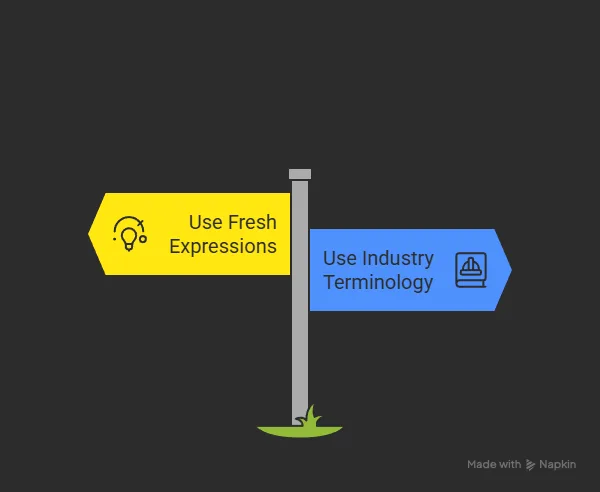
6. Awkward Transitions Between Ideas
AI often struggles with natural flow between topics or ideas.
The Problem: When writing with AI, section transitions can feel forced or formulaic. AI commonly overuses phrases like “Now, let’s discuss…” or relies heavily on question-and-answer patterns like “So, what does this mean? Let’s find out.”
The Solution: Create more natural bridges between ideas. Writing with AI flows better when you connect concepts through shared themes or logical progression rather than artificial signposting.
Instead of keeping this AI transition: “Now that we’ve discussed the problems with AI writing, what are the solutions? Let’s explore them in detail.”
Try something more conversational and connected: “These AI writing challenges might seem daunting, but they’re actually opportunities to leverage both machine efficiency and human creativity. Here’s how to transform robotic text into compelling content.”
The revised transition maintains continuity by framing problems as opportunities, creating a more natural flow without relying on obvious transitional phrases.
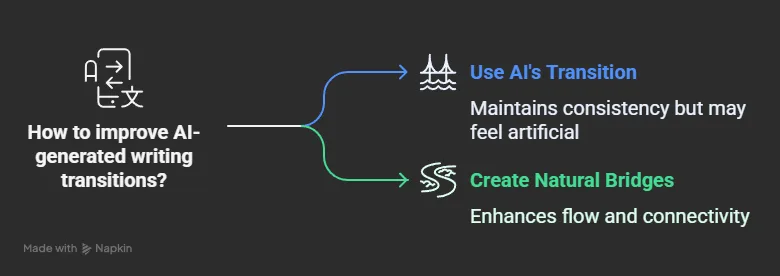
7. Emotionally Flat Tone Throughout the Content
AI struggles to maintain consistent emotional resonance or humor in its writing.
The Problem: When writing with AI, the emotional tone often feels inauthentic or superficial. AI might use emotion-related words without capturing the subtle dynamics of genuine feeling.
The Solution: Adjust the emotional temperature throughout your piece. Writing with AI becomes more engaging when you incorporate genuine reactions, humor, and passion where appropriate.
Instead of this flat AI statement: “This book provides valuable insights about marketing.”
Try something with authentic emotional impact: “This book shattered my understanding of marketing. I found myself both nodding vigorously and occasionally arguing out loud with the author—much to the confusion of other coffee shop patrons. It’s rare to find content that’s both intellectually challenging and practical enough to implement immediately.”
The revision shows a genuine emotional reaction, includes a humorous visual detail, and explains why the reaction occurred, making it feel authentic rather than performative.
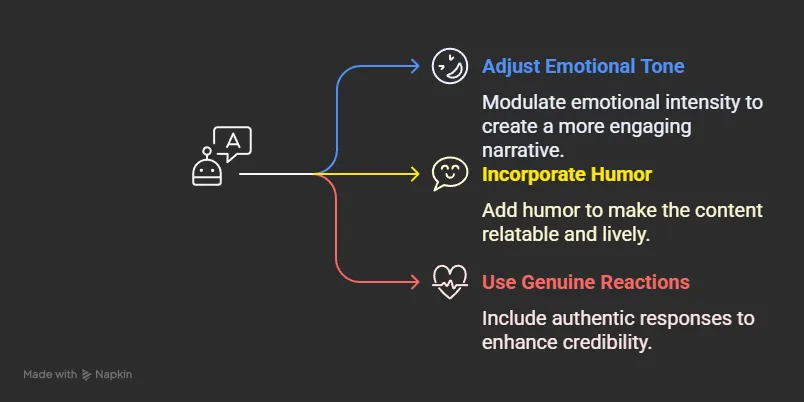
Advanced Techniques for Writing With AI That Feels Human
Beyond fixing these common issues, there are several advanced strategies that can elevate your writing with AI to a level indistinguishable from purely human content.
Develop a Consistent Voice
One of the most effective ways to humanize AI content is to overlay a consistent, distinctive voice. Whether you’re aiming for authoritative, conversational, humorous, or thoughtful, apply this voice consistently when writing with AI.
Start by defining 3-5 personality traits for your writing persona. Are you the encouraging mentor? The straight-talking expert? The curious explorer? Once defined, review each AI-generated section and adjust the tone to match this persona.
“I’ve developed what I call my ‘editorial filter,'” explains Thomas, a content marketer. “When writing with AI, I imagine my content being spoken by a specific person—in my case, a wise but approachable professor. If a sentence doesn’t sound like something this character would say, I rewrite it.”
Use Imperfection Strategically
AI writing tends to be structurally perfect, which paradoxically makes it feel less human. When writing with AI, consider deliberately introducing elements of natural human communication:
- Occasional parenthetical asides (like this one) that share a relevant thought
- Strategic sentence fragments. Just like real people use.
- Conversational markers like “honestly,” “look,” or “here’s the thing”
- Appropriate contractions and casual phrasing
The goal isn’t to make your writing sloppy, but to incorporate the natural patterns of human expression that AI often misses when writing with AI tools alone.
Break Expected Patterns
AI follows predictable patterns because it’s trained on existing content structures. When writing with AI, surprise your readers by occasionally breaking these expected patterns.
If a section begins to feel formulaic, introduce an unexpected element—a relevant question, a contradictory perspective, or even a brief creative metaphor that makes readers pause and think.
“The most engaging writers don’t just inform—they surprise,” notes writing coach Elena Sanders. “When writing with AI, look for opportunities to introduce the unexpected. If you’ve made three supporting points, don’t automatically add a fourth just because it’s symmetrical. Maybe that’s where you add a counter-argument or a personal story instead.”
Layer in Sensory Details
One significant advantage humans have over AI is our sensory experience of the world. When writing with AI, incorporate specific sensory details that machines simply cannot invent:
- The particular quality of light in your office when you tested the software you’re reviewing
- The distinctive sound a well-made product makes compared to its cheaper counterparts
- The texture or tactile feedback of an item you’re describing
These sensory elements aren’t just decorative—they signal authentic experience that AI cannot replicate when writing with AI tools.
Writing With AI: A Practical Workflow
Now that we understand the problems and solutions, let’s explore a practical workflow for writing with AI that produces genuinely human-sounding content.
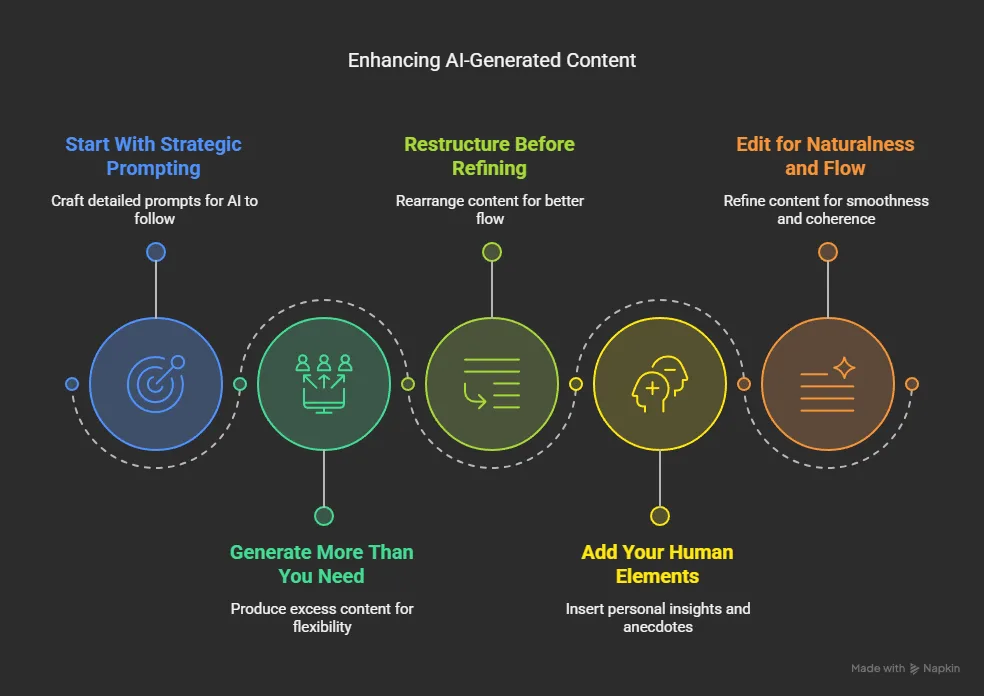
Step 1: Start With Strategic Prompting
The quality of AI output depends largely on your input. When writing with AI, craft detailed prompts that specify:
- Your target audience and their level of familiarity with the topic
- The specific voice or tone you want to achieve
- The structure or format you prefer
- Examples of the style you’re aiming for
For example, instead of asking the AI to “Write an article about email marketing,”
try: “Write the first draft of a conversational guide to email marketing for small business owners who are beginners. Use a friendly, supportive tone like you’re explaining concepts to a friend over coffee. Include sections on building a list, crafting effective subject lines, and measuring success.”
This detailed prompt gives the AI clear direction, resulting in output that requires less extensive humanization.
Step 2: Generate More Than You Need
When writing with AI, generate 30-50% more content than your final word count target. This gives you room to cut weaker sections and keep only the strongest material.
“I ask my AI writing assistant for 1,500 words when I only need 1,000,” shares content creator Priya Malhotra. “This gives me the freedom to cut anything that sounds too generic or artificial, keeping only the parts that work well or can be effectively humanized.”
Step 3: Restructure Before Refining
Before diving into line-by-line editing, assess the overall structure of your AI-generated draft. When writing with AI, you’ll often find logical gaps or sections that would flow better in a different order.
Rearrange sections based on natural thought progression rather than formulaic structures. This large-scale restructuring immediately differentiates your content from typical AI output.
Step 4: Add Your Human Elements
Now, strategically incorporate elements that AI cannot generate:
- Personal anecdotes or case studies you’ve personally encountered
- Industry insights from your unique experience
- Opinions or perspectives based on your values and observations
- Sensory details from real experiences
- Cultural references or analogies meaningful to you
These additions are the clearest signals of human authorship when writing with AI.
Step 5: Edit for Naturalness and Flow
Finally, read your content aloud to identify any remaining artificial elements. When writing with AI, this verbal review helps catch phrases that look fine on paper but sound unnatural when spoken.
Pay special attention to transitions between ideas, sentence rhythm variations, and emotional consistency. Make sure the piece flows naturally from beginning to end without jarring shifts in tone or perspective.
Writing With AI: Ethical Considerations
As we improve our skills in writing with AI, we must also consider the ethical dimensions of this practice.
Transparency With Your Audience
Different contexts call for different levels of transparency about your use of AI in your writing process. Consider your relationship with your audience and the expectations in your field.
Some creators openly discuss their process of writing with AI, viewing transparency as a form of authenticity. Others focus on delivering valuable content, regardless of how it was produced.
“I view AI as just another tool in my creative process, like spell-check or thesaurus,” explains novelist Marco Chen. “I don’t announce when I’ve used these other tools, but I always ensure the final work represents my voice and vision. The same applies when writing with AI—my readers care about the quality of the experience, not the specifics of my process.”
Whatever approach you choose, ensure your content delivers genuine value and represents your authentic perspective, even if AI helped shape the expression of that perspective.
Responsibility for Accuracy
When writing with AI, remember that you remain responsible for the accuracy of your content. AI can generate plausible-sounding information that is factually incorrect or outdated.
Always verify facts, statistics, and claims before publishing content created through writing with AI. This verification process is not just about avoiding embarrassment—it’s about maintaining trust with your audience.
The Future of Writing With AI
As AI writing tools continue to evolve, the relationship between human creativity and machine assistance will transform as well. The skills we’re developing now—humanizing AI content, infusing personal elements, and maintaining distinctive voices—will become even more valuable.
“I believe we’re moving toward a future where writing with AI will be less about fixing robotic language and more about directing creative collaboration,” predicts technology writer Sasha Williams. “The writers who thrive will be those who know how to guide AI with vision and purpose while adding the uniquely human elements that technology cannot replicate.”
Writing with AI offers unprecedented efficiency and assistance, but it doesn’t replace the need for human creativity and perspective. By understanding the telltale signs of AI-generated content and systematically addressing them, you can create material that harnesses the power of technology while maintaining that essential human connection.
Remember that the goal of writing with AI isn’t to trick readers or detection systems—it’s to create valuable, engaging content more efficiently. The techniques we’ve explored help ensure that the efficiency gains from AI don’t come at the cost of quality or authenticity.
With practice, writing with AI becomes less about fixing robotic text and more about establishing a creative partnership where technology handles the routine aspects of content creation while you focus on the elements that only humans can provide—personal experience, emotional connection, and original insight.
Whether you’re a professional writer looking to increase productivity, a content marketer managing multiple channels, or a business owner creating materials for your audience, these strategies will help you make the most of AI writing tools while ensuring your content remains distinctively, recognizably human.
The future belongs to those who can masterfully combine the efficiency of AI with the irreplaceable creativity of human expression. By applying these principles, you’re not just improving your current content—you’re developing skills that will remain valuable throughout the evolving landscape of writing with AI.
How can I tell if my writing sounds too much like it was generated by AI?
The biggest indicators include overly safe language without strong opinions, repetitive sentence structures, excessive wordiness, lack of personal stories or experiences, reliance on clichés, awkward transitions between ideas, and an emotionally flat tone throughout. Reading your content aloud is one of the best ways to catch these issues, as AI-generated text often sounds unnatural when spoken.
Will using AI for writing hurt my reputation as a writer or content creator?
Not if you use AI as a tool rather than a replacement. Many professional writers and content creators use AI to generate first drafts or overcome writer’s block, then heavily edit and personalize the content. The key is ensuring your final piece contains your unique voice, experiences, and insights. When AI assists but doesn’t replace your creative input, your reputation remains intact.
Do I need to disclose that I used AI in my writing process?
This depends on your industry, audience expectations, and personal ethics. In academic, journalistic, or research contexts, transparency about AI use may be expected or required. For marketing, creative writing, or business content, many creators view AI as just another writing tool (like grammar checkers or templates) that doesn’t require specific disclosure. Consider your relationship with your audience and the norms in your field when making this decision.
How much editing do AI-generated drafts typically need?
Most AI-generated content requires significant editing to sound fully human—typically between 30-50% of the text needs revision. This includes restructuring sections for better flow, adding personal anecdotes and specific details, varying sentence structures, removing redundancies, and infusing your unique perspective. The level of editing needed decreases as you become more skilled at crafting effective prompts.
Can AI detectors still flag my content even after I’ve humanized it?
Current AI detection tools have significant limitations and often produce false positives (flagging human content as AI-generated) or false negatives (missing AI content). After applying the humanization techniques outlined in the article—especially adding personal experiences, varying sentence structures, and incorporating unique metaphors—most content passes AI detection. However, these tools continue to evolve, which is why focusing on creating valuable, authentic content rather than just “beating detectors” is the more sustainable approach.
